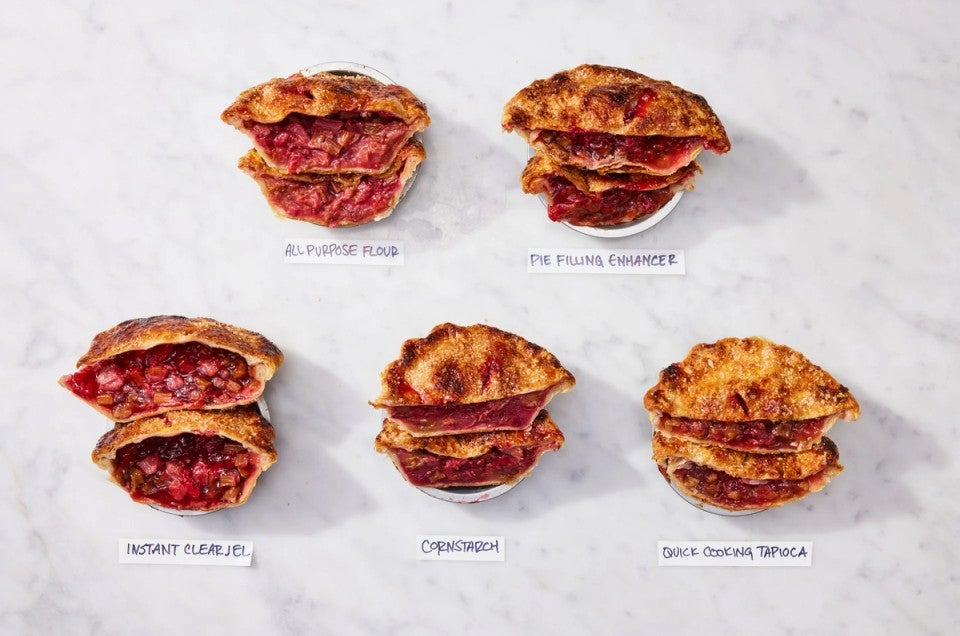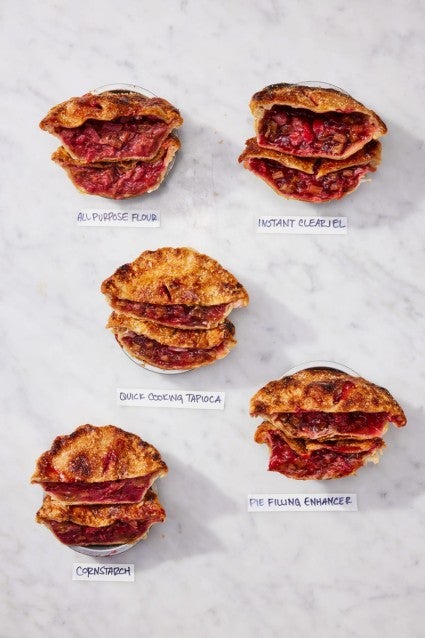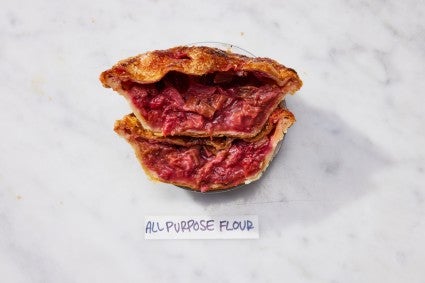Baking trials: What’s the best way to thicken fruit pie filling?
There are a lot of options! Here’s your guide.


There's the fruit pie of your dreams, the one that cuts easily, with every slice revealing a jammy, vibrant fruit filling that gently oozes onto the plate. But if it's done wrong? The slice is more like a puddle, disintegrating when you try to serve it and leaving behind a lake of fruit juice in the middle of your pie pan. Or it's overthickened, the fruit filling so stiff it brings bouncy balls to mind. Given that moisture content changes from fruit to fruit and throughout the season, how can you ensure a just-right filling? Read on.
The key to achieving the former, and not the latter, is to thicken your fruit pie filling correctly. Essentially, this means adding a starch that can soak up the liquid released by the fruit as it bakes, lending structure to the fruit and helping it set in the oven.
You can thicken your fruit pie filling with lots of different starches — including all-purpose flour, cornstarch, tapioca, and more — and the amount you use will depend on the fruit you’re using. For instance, some fruits have more natural pectin and less moisture (such as apples) and thus need less thickener, while others, like strawberries, have little natural pectin and rely on that additional starch to set. It’s not an exact science, but to guide you, we have a whole Pie Thickener Chart. Our fruit pie recipes are also written with different thickening options best suited to the pie itself; if you’re following a King Arthur recipe, follow the quantity listed on the recipe for the best results.
While many different thickeners will work, they each yield slightly different results. For instance, some yield a different mouthfeel or more opaque appearance, while some might make a pie filling firmer.

As mentioned above, how you thicken and how much thickener you use will depend on the types of fruit and the pie recipe itself. But for this test, we baked five mini strawberry-rhubarb pies. Each filling used a different type of thickener, following the guidelines listed in our Pie Thickener Chart.

In short, all of these pie thickener methods worked. They yielded a fruit filling that was stable instead of soupy; when we cut into each, the filling remained intact and did not run out onto the plate. I’d happily serve a slice of each to friends.

The winners: Fruit pie fillings thickened with Instant ClearJel and Pie Filling Enhancer had the best texture — juicy without being gummy or starchy. These two fillings also had the clearest appearance, which really allowed the bright color of the fruit to shine.

The runners-up: The cornstarch-, tapioca-, and all-purpose flour-thickened fillings were slightly cloudy. In addition, the all-purpose flour also had a faintly starchy (though not noticeably unpleasant) mouthfeel, while the tapioca filling was more sticky.
To summarize: We recommend using Instant ClearJel or Pie Filling Enhancer, but cornstarch, flour, and quick-cooking tapioca will also work well if you don’t have other options available.
Some additional pie tips to keep in mind:
Fresh farmers market fruit, especially berries, is often juicier than fruit you buy at the supermarket. You’ll want to increase your thickener accordingly to account for this extra moisture. Because all fruit will vary, the amount you increase isn’t a perfect science, but we recommend upping the thickener by about 25% for particularly juicy fresh fruit.
In past testing, we’ve found that a double-crust pie needs more thickener than an open-faced pie, or one with a lattice crust or pastry cutouts on top. Which makes sense: Even with vents in the top crust, that layer of pastry is preventing steam from escaping as the pie bakes. The liquid that would evaporate from an open-faced pie is trapped in a double-crust pie. Thus more thickener is needed to account for the extra liquid.

Whichever thickener you use, wait until your pie is cool before slicing into it. This additional time gives the fruit filling a chance to fully set. If you cut too early, while the pie is still warm, it’s much more prone to slumping and leaking. We know it’s hard, but for the sturdiest slices, make sure to wait until your pie is fully cooled; in warm weather, this can take many hours, so plan accordingly!
Learn more essential tips and techniques for the best pie in our guide on How to Bake Pie.
Cover photo by Rick Holbrook; food styling by Kaitlin Wayne.


